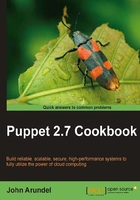
Chapter 2. Monitoring, Reporting, and Troubleshooting
"Found problem more than one. However, this does not mean that relevant part is thing by mistake. Could be fertilized by special purpose in other application program."—Error message
In this chapter, we will cover the following topics:
- Generating reports
- E-mailing log messages containing specific tags
- Creating graphical reports
- Producing automatic HTML documentation
- Drawing dependency graphs
- Testing your Puppet manifests
- Doing a dry run
- Detecting compilation errors
- Understanding Puppet errors
- Logging command output
- Logging debug messages
- Inspecting configuration settings
- Using tags
- Using run stages
- Using environments
We've all had the experience of sitting in an exciting presentation about some new technology, and then rushing home to play with it. Of course, once you start experimenting with it, you immediately run into problems. What's going wrong? Why doesn't it work? How can I see what's happening under the hood? This chapter will help you answer some of these questions, and give you the tools to solve common Puppet problems. We'll also see how you can generate useful reports on your Puppet infrastructure, and how Puppet can help you monitor and troubleshoot your network as a whole.